
IAN SAVAGE
DEPARTMENT OF ECONOMICS
Department of Economics > Ian Savage > Transportation Safety

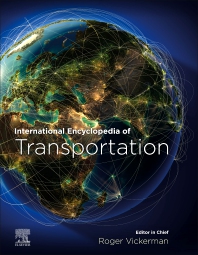 1. Ian Savage (2021). Economics of transportation safety. In Roger W. Vickerman (ed) International Encyclopedia of Transportation. Elsevier.
1. Ian Savage (2021). Economics of transportation safety. In Roger W. Vickerman (ed) International Encyclopedia of Transportation. Elsevier.
[Publisher's Website] [Manuscript Version]
Transportation is characterized by high speeds and heavy mechanical equipment. Consequently the risks of personal injury and property damage are considerable. Unlike other attributes of transportation such as price and service frequency, users have great difficulty in determining and interpreting safety risks. They also suffer from cognitive problems in taking appropriate actions to obtain the level of safety that they desire. Consequently market forces result in more crashes than society prefers. Economists, psychologists and engineers have been active in determining why users exercise less care than they should, and the market interventions that can change users’ incentives. These interventions include insurance, liability rules, information provision and enforcing regulations on user conduct and the design of vehicles and infrastructure.
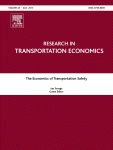 2. Ian Savage (2013). Reflections on the economics of transportation safety. Research in Transportation Economics: The Economics of Transportation Safety 43(1):1-8
2. Ian Savage (2013). Reflections on the economics of transportation safety. Research in Transportation Economics: The Economics of Transportation Safety 43(1):1-8
[Publisher's Website] [Manuscript Version]
This is the introductory chapter to the special issue of Research in Transportation Economics on the economics of transportation safety for which I was the guest editor. These introductory comments were intended to be more extensive than just a summary of the papers in this volume, but less extensive than a comprehensive treatise on the economics of transportation safety. Primarily it is a personal reflection on the issues I have found to be important, and some thoughts on the strengths and weaknesses of the existing literature. The paper concludes that transportation safety provides a wide variety of interesting topics for investigation by economists, and that there are plenty of unanswered questions for the next generation of the profession to tackle.
Link to the table of contents of the special issue for which I was the guest editor.
 3. Ian Savage (2013). Comparing the fatality risks in United States transportation across modes and over time. Research in Transportation Economics: The Economics of Transportation Safety 43(1):9-22
3. Ian Savage (2013). Comparing the fatality risks in United States transportation across modes and over time. Research in Transportation Economics: The Economics of Transportation Safety 43(1):9-22
[Publisher's Website] [Manuscript Version] [Data Appendix]
This paper analyzes the transportation fatality risk in the United States. The analysis is in two parts. The first part compares the relative risks of the different modes based on data for the decade from 2000 to 2009. The second part is a time-series analysis for each mode using annual data from 1975 to 2010. By almost any measure, transportation is considerably safer now than it was in the mid 1970s. The improvement is especially noticeable for commercial modes such as aviation, railroads and maritime. Even the risks from private highway driving have halved during the past thirty-five years.
 4. Ian Savage (2010). Safety in Transport. In Kenneth Button, Henry Vega and Peter Nijkamp (eds.) A Dictionary of Transport Analysis. Cheltenham, UK: Edward Elgar.
4. Ian Savage (2010). Safety in Transport. In Kenneth Button, Henry Vega and Peter Nijkamp (eds.) A Dictionary of Transport Analysis. Cheltenham, UK: Edward Elgar.
[Publisher Information] [Manuscript Version]
A 1,500 word dictionary entry on the economics of transportation safety highlighting recent trends, market failures and public policy responses.
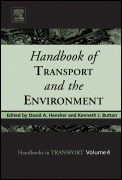 5. Ian Savage (2003). Safety. In David A. Hensher and Kenneth J. Button (eds.)
Handbook of Transport and the Environment. Amsterdam: Elsevier Science.
5. Ian Savage (2003). Safety. In David A. Hensher and Kenneth J. Button (eds.)
Handbook of Transport and the Environment. Amsterdam: Elsevier Science.
[Publishers Website] [Manuscript Version]
The vast majority of lapses in safety in the transport provision cause injury and property damage, but have negligible effects on the environment. However, there are occasions when the release of harmful freight pollutes the environment, and poses a health risk to bystanders. Some of these releases occur after collisions or other types of crashes. However, many occur due to safety lapses that do not involve crashes and often are associated with loading and unloading of transport vehicles. This chapter goes beyond understanding the incentives for firms to provide safe transportation (contained in a companion chapter described below) to provide a more detailed analysis of the subset of crashes or operational errors that cause negative spillover effects, called "externalities," on third parties.
This chapter discusses evidence on the probability and severity of hazardous materials releases, and public perceptions of the risks. It then discusses the evidence as to whether legal liability is sufficient to provide the correct incentives to shippers and transportation firms. Because legal mechanisms are seen as inadequate, public policy has intervened by working with transport firms on the packaging of hazmats, routes to reduce public exposure and the provision, equipping and training of emergency response teams. The chapter describes the track record of quantitative risk assessment (QRA) models used to determine the desirability of these policies, and finds that rival models can provide very different results and divergent conclusions, and also tend to focus exclusively on the effects on humans. There is much work still be done on evaluating the probability and the consequences of hazmat releases on the environment.
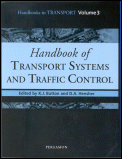 6. Ian Savage (2001). Transport Safety. In David A. Hensher and Kenneth J. Button (eds.)
Handbook of Transport Systems and Traffic Control. Amsterdam: Elsevier Science.
6. Ian Savage (2001). Transport Safety. In David A. Hensher and Kenneth J. Button (eds.)
Handbook of Transport Systems and Traffic Control. Amsterdam: Elsevier Science.
[Publishers Website] [Manuscript Version]
This paper is a handbook chapter presenting a overview of transportation safety, and references important introductory and seminal texts. It covers the safety of both private automobile driving and commercial transportation safety.
The paper initially presents some general data on transportation fatalities in the United States and
some measures of the magnitude of risk probabilities. It then discussed the "market failures" that
cause the "transportation safety problem:"
- Imperfect information by consumers
- Cognitive failures by consumers
- Myopia by carriers
- Externalities
- Bilateral Crashes
- Imperfect Competition
The paper concludes by discussing public policy towards addressing these market failures for both automobile driving and commercial transportation.
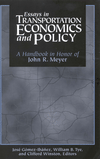 7. Ian Savage (1999). The economics of commercial transportation safety. In José A. Gómez-Ibáñez, William B. Tye and Clifford Winston (eds.) Essays in Transportation Economics and
Policy: A Handbook in Honor of John R. Meyer. Washington D.C.: Brookings Institution.
7. Ian Savage (1999). The economics of commercial transportation safety. In José A. Gómez-Ibáñez, William B. Tye and Clifford Winston (eds.) Essays in Transportation Economics and
Policy: A Handbook in Honor of John R. Meyer. Washington D.C.: Brookings Institution.
[Publisher Information] [Manuscript Version]
This paper is part of a collection of essays reviewing transportation economics. It deals with safety in commercial transportation (and not with private automobile driving). It presents some overall statistics on fatalities and risks, and then discusses trends in recent safety performance in commercial aviation, trucking and railroads in the United States. The paper then discusses how well the free market provides consumers with the level(s) of safety they desire, and the types and magnitudes of "market failures" that may occur.
Many of the market failures are addressed by existing legal and insurance mechanisms, however there is a necessity for safety regulations. The paper describes why the law and insurance does not entirely correct market failures, and the effectiveness of safety regulation in recent years in trucking, railroads and aviation.
The paper concludes by discussing policy recommendations for making the public more informed, making insurance companies take a greater role, and for innovative new methods for safety regulations. The latter include setting safety performance targets for carriers rather than specifying the design of equipment and the training of staff.
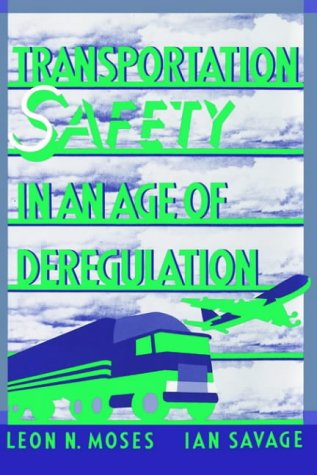 8. John C. Panzar and Ian Savage (1989). Regulation, deregulation and safety: an economic
analysis. In Leon N. Moses and Ian Savage (eds.), Transportation Safety in an Age of
Deregulation. New York: Oxford University Press.
8. John C. Panzar and Ian Savage (1989). Regulation, deregulation and safety: an economic
analysis. In Leon N. Moses and Ian Savage (eds.), Transportation Safety in an Age of
Deregulation. New York: Oxford University Press.
[Publisher Information]
This paper was part of the 1987 Transportation Deregulation and Safety conference and explored, at a theoretical level, the nature of the linkages between economic deregulation and safety. The paper discusses that the level of safety provided by a firm is an economic decision, and that is likely that in a competitive world that several different levels of safety may be offered by rival carriers. Then the role that imperfect information, imperfect competition and congestion of common infrastructure may have in producing "market failures" is discussed.
An analytical model of safety determination is presented where the level of safety depends on economic factors, the quantity of common infrastructure, and the resources spent by government to promulgate and enforce safety regulations. The paper concludes that investigation of the effects of deregulation on safety cannot be investigated by looking at economic changes alone. One must also incorporate how government infrastructure provision and surveillance activities responded to the changes caused by deregulation.
© 2021 - Last Updated: 05/17/2021 - Disclaimer